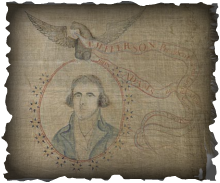Content Summary Jefferson Victory Banner
At the turn of the 19th century, America was facing many critical issues. Appropriately titled the "Revolution of 1800" by Thomas Jefferson himself (transcript here), America experienced its first relatively peaceful transition from one political party to the next. The two parties, the Federalists and the Anti-Federalists, backed one of the candidates (Burr and Jefferson, respectively). The Federalists desired to have a close relationship with Great Britain, whereas the Anti-Federalists wanted a close relationship with the French. The key issues at this time included opposition to taxes imposed by Congress intended to fund military ventures and the Alien and Sedition Acts.
The two headliners for the election of 1800, Aaron Burr and Thomas Jefferson, both had decent political resumes. Burr had previously been elected to the New York State assembly and served as a U.S. Senator from 1791-1797 from the state of New York (Online Highways). Jefferson had previously served as the wartime governor for the state of Virginia and as Vice President for John Adams (Online Highways). Additionally, he was the first United States Secretary of State under George Washington (Online Highways).
When the electoral votes were tallied, Burr and Jefferson had tied. The vote was then sent to the House of Representatives. Both political parties heavily campaigned for their candidates with Jefferson receiving support from Alexander Hamilton among other prominent leaders of the time. Jefferson was declared the winner by the House of Representatives after 35 ballots. Burr served as Vice President under Jefferson.
Following this election, Congress approved the 12th Amendment (which required electors to vote for both the President and Vice President) in order to avoid the dilemma they faced in this pivotal election.
The two headliners for the election of 1800, Aaron Burr and Thomas Jefferson, both had decent political resumes. Burr had previously been elected to the New York State assembly and served as a U.S. Senator from 1791-1797 from the state of New York (Online Highways). Jefferson had previously served as the wartime governor for the state of Virginia and as Vice President for John Adams (Online Highways). Additionally, he was the first United States Secretary of State under George Washington (Online Highways).
When the electoral votes were tallied, Burr and Jefferson had tied. The vote was then sent to the House of Representatives. Both political parties heavily campaigned for their candidates with Jefferson receiving support from Alexander Hamilton among other prominent leaders of the time. Jefferson was declared the winner by the House of Representatives after 35 ballots. Burr served as Vice President under Jefferson.
Following this election, Congress approved the 12th Amendment (which required electors to vote for both the President and Vice President) in order to avoid the dilemma they faced in this pivotal election.

